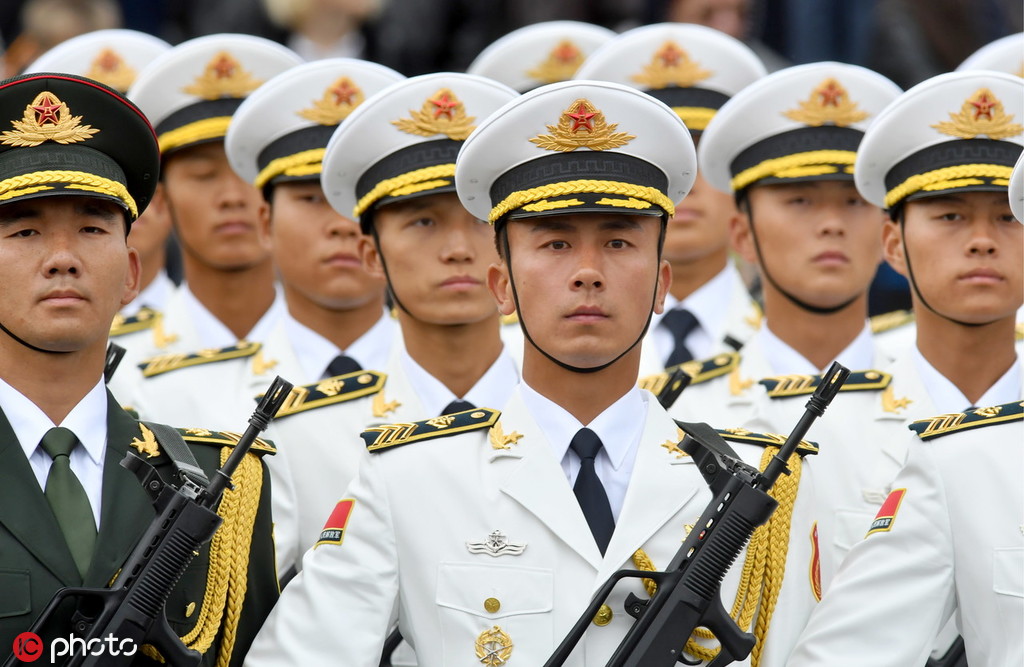PLA aims to become global stabilizer in new era
By Li Zheng | China Daily | Updated: 2019-08-02 08:02

The white paper, "China's National Defense in the New Era", issued on July 24 is the first systematic and comprehensive white paper on China's defense in four years, and details the new command and management system of the People's Liberation Army and its new strategic tasks and long-term development plan.
The white paper is also a timely move to scotch rumors and speculations, including recent media reports claiming that China and Cambodia have signed a "secret agreement" which allows China to use a naval base of Cambodia and that, in addition to Gwadar Port, China is also seeking to build a military base in Jiwani, Pakistan.
These reports suggest China's Belt and Road Initiative is moving toward militarization. Some Western scholars even believe China's real purpose behind the initiative is military expansion, and economic cooperation is only as a "bait" to "entrap" countries.
Given the current tensions between China and the United States, it has become easier for some to hype the "China conspiracy" theory, which stems from a misunderstanding of China's military strategy and intentions. To outsiders, China's military growth and defensive defense policy are a contradiction. The US believes that because of its growing military power, China will inevitably seek goals beyond the mere safeguarding of national security. The US also speculates that China, like other powerful countries, will pursue regional or global hegemony using its military power. The new defense white paper clears such misunderstandings.
While acknowledging the recent changes to the global environment and China's military, the new white paper's assessment of the international situation is more cautious than the 2010 version. An increasingly fierce global military competition has made it necessary for China to catch up with the world's leading military powers, implement extensive military reforms and establish a new management and operational command system. China now has a clearer national defense strategy, which focuses on improving combat readiness: "We will not attack unless we are attacked, but we will surely counterattack if attacked."
This does not mean China will fundamentally change its defensive defense policy. In fact, the new white paper demonstrates that China has found ways to resolve the contradiction between military expansion and the defensive defense policy-by increasing transparency as China's military strength grows. The new white paper not only details the new composition and scale of the combat forces, but also reflects the strategic planning of China's military modernization. The overall plan is to compress non-combatants, significantly reduce the size of the army's active service, and moderately enhance strategy and combat forces in emerging areas. Which show China's military strategy remains focused on national defense.
The second solution to the perceived contradiction is to make clear the limits of China's defense spending. The white paper uses data to show that China's defense spending growth is generally consistent with its economic and fiscal conditions, and that there remains a large gap between the defense budgets of China and some developed countries. Besides, China has not increased the defense spending because of changes in the international environment nor does it intend to use the military industry to boost its economy.
The third solution is to increase the Chinese military's supply of international public safety products. The white paper says one of the PLA's long-term tasks is to build a community of a shared future for mankind. The goal is to make the PLA a force to safeguard world peace, one that actively supports United Nations peacekeeping, helps with international disaster relief, provides humanitarian assistance and takes global counterterrorism measures. China believes the unstable factors in the world are connected, and that controlling and reducing these factors would boost its national security, too.
The fourth solution is to strengthen global military cooperation and actively integrate with the international security system. The white paper says the Sino-US military relationship has shown a generally positive trend, and China wants to further stabilize Sino-US relations. It is also more actively participating in the regional security architecture in order to peacefully resolve the disputes and differences with its neighbors.
It is thus clear that the PLA's goal in the new era is to become a constructive force for maintaining the world order and global peace. China has long believed the purpose of military should not be to bully other countries but instead to maintain peace. This principle will help a rising China to better integrate with the world.
The author is an assistant research fellow at the China Institutes of Contemporary International Relations.
Source: chinausfocus.com
The views don't necessarily represent those of China Daily.
























